We’re almost there, folks.
It’s becoming tougher and tougher to derive meaning out of these meaningless regular-season games as the season winds down here, but we’ll try our best after Toronto’s 4-3 overtime loss to Ottawa on Wednesday night.
The Leafs got outplayed at 5v5 by the Senators, both in terms of shot quantity and quality. You could downplay that, given the stakes of the game and that Ottawa has been one of the hotter teams in the league lately, but we always try to be objective here and point out the flaws in the performances when we see them.
This wasn’t Toronto’s best stretch of hockey, yet they were still able to squeak out a point after a late goal from Auston Matthews. We probably shouldn’t take too much out of a game like this, so just keep that in mind for tonight’s evaluations.
Who’s ready for some super meaningful Leafs Report Cards?
5 Stars
Game Puck: John Tavares (C, #91) — Jokes aside, it’s nice to see John Tavares look more like John Tavares offensively in the second half of this season. He’s back to beating guys 1-on-1 off the rush, making skilled plays to get himself and his teammates into open ice.
I’d argue Tavares’ biggest impact came on the cycle, winning the 50-50 battles along the boards to secure possession, followed by some high-skill plays to open up space for some offense.
This is a good example of the quick turns Tavares often makes out of the corner to create passing lanes, which pays off in the form of a primary assist here. He also picked up a goal off of a beautiful pass from William Nylander, which we’ll clip in his section.
It is worth noting Tavares needs to make quicker decisions with the puck after gaining the zone on the power play — too often entries would die on his stick along the left wall — but aside from that, he was pretty dominant tonight.
Jake Muzzin (LD, #8) — Games like these remind me why I’m such a big fan of Jake Muzzin. Before we get to his power-play bomb, let’s talk about his passing. I’ve been critical of his poor zone exit numbers this season, but he was actually great in this game at making subtle little chip passes to start the breakout.
Muzzin also did well as the last line of defense on Toronto’s PK and even activated in the rush for a few “power kill” chances, but let’s be honest, it was his impact on the PP that was most impressive tonight. He let go an absolute bomb from the point off of a pass from Joe Thornton, beating Filip Gustavsson clean from 50 feet out. Even though Morgan Rielly and Rasmus Sandin are much more mobile at the top of the PP, Muzzin is a legitimate shot threat from there.
Just something to think about, especially considering how frustrating Toronto’s power play has been lately.
Nick Foligno (LW, #71) — Most of the Leafs were in Regular Season Mode tonight. Nick Foligno had the switch flicked to “Playoff Mode”, going hard into every puck battle, getting his body on an opposing player when he had the chance, and even got himself into a skirmish with Brady Tkachuk after the whistle.
That’s what Leafs fans want to see. It’s nice when you can combine that energy with sound defensive positioning. As always, Foligno seemed to find himself standing in the right spots on the defensive side of the puck, which is why he’s been so effective at limiting shots and scoring chances throughout his career.
I like his fit alongside Tavares on that second line, especially when they get cycling in the offensive zone. Much like Toronto’s captain, Foligno is excellent at winning puck battles in tight spaces, which should create plenty of room for Nylander to scoop up pucks and make some high-skill plays in open ice.
4 Stars
William Nylander (RW, #88) — Like say, this.
Much like Matthews, Nylander has the uncanny ability to bat pucks out of the air as if it were a casual saucer pass. We’ve seen him do this enough times over the years, usually in the neutral zone, to know this isn’t a fluke. Plays like these are possible when you have all-world puck skills.
Aside from the highlight reel assist, this wasn’t Nylander’s most dominant game, although he did have bursts where he created some rush chances out of nothing. The power play is more of a team-level struggle, although you would like to see Nylander retrieve more loose pucks after the initial shot is taken, especially considering he tends to be the one closest to rebounds at the net front. It was nice to see him swing back and help out with one of the 5v4 entries, which is a look I think we’ll see more from Toronto in their first-round series against Montreal.
Joe Thornton (LW, #97) — It took 55 games, but we finally got to see what Thornton would look like running PP2 out of the left corner. Call me crazy, but I thought it worked. Alex Kerfoot isn’t the perfect fit for the bumper role, yet Thornton was still able to rip some passes around the OZ to help space out the ice.
Now, you don’t want a second power-play unit where the puck spends most of the time rimming around the boards, but Thornton’s quick decisions from the left wall helped open up ice for everyone else. Just ask Muzzin.
At even strength, the Veteran Line didn’t tilt the ice as well as the eye test might have suggested. Then again, it was pretty cool to watch Thornton-Spezza-Simmonds all deliver a few crunching hits one after another. I’d also like to point out that Thornton has been surprisingly strong on the backcheck this season, which you wouldn’t necessarily expect considering his foot speed.
Age is just a number, people.
Alex Kerfoot (C, #15) — The large sample nerd in me wants to point out his underwhelming 5v5 results this season when he plays without Tavares-Nylander. The small sample post-game analyst in me would like to inform you that he looked great tonight.
Kerfoot was using his speed to transition the puck up the ice successfully. He looked more dangerous than usual, giving the goaltender a little pump-fake before making his drop-passes off the rush. As much as I want to make fun of them, it was one of those quick little back-passes to Thornton that led to the Muzzin power-play goal, so what do I know?
3 Stars
Auston Matthews (C, #34) — It’s difficult to constantly assess greatness, since we tend to hold these upper-echelon players to an almost unattainable standard. For example, I didn’t have too many notes on Auston Matthews tonight and he casually finished the game with seven shot attempts, five chances from the slot, and one goal.
It’s crazy, but we’ve come to expect these types of performances from him.
Length — I just can’t quit the Pierre Engvall and Ilya Mikheyev pairing. I know Sheldon Keefe might prefer Riley Nash in the defensive bottom-six C role, but there’s something about watching two long, athletic skaters suffocate opposing forwards in the neutral zone that I get some kind of sick joy out of watching.
For fun, iso-cam one of these players on the PK the next chance you get. Mikheyev is phenomenal at defending the blue line in a neutral zone trap, mainly because he can cover so much ground with his long stick and quick feet.
With Engvall, I don’t know what to do sometimes because there’ll be sequences where he forces a turnover, bursts up the ice with speed, and actually make a decent offensive play. Then there are other times he’ll end possessions by firing a 0.02 xG shot from distance, putting his team back on defense.
Keefe has mentioned he wants Engvall to be “stronger” in puck battles, which to his credit, we saw more of tonight. I doubt it will be enough to move him up the depth chart over the more physical Nash, but Engvall has so many interesting tools that I do wonder if reuniting the HEM line in the playoffs is a contingency plan that should be looked at a bit more closely.
After all, they dominated third-line minutes together this season.
Did Their Jobs — Even though Travis Dermott and Justin Holl aren’t on the same pairing anymore, I decided to group them together tonight because I had a similar takeaway on both of them. They did their jobs.
Dermott’s partner struggled — which we’ll get to in the Ben Hutton section — and the pairing still managed to out-chance their opponents at 5v5. That speaks to Dermott’s ability to tilt the ice, largely thanks to his tight gap. He also had a few nice offensive plays where he looked off the opposing defender before making the other pass.
That element of deception has been missing from his offensive game since he burst onto the scene in his rookie season, so maybe that’s a taste of what Seattle Kraken fans will see on their second pair next year. As a long-time Dermott truther, that’s a situation where I could see him having success at 5v5.
Finishing up with Holl, I can honestly say I didn’t have too many notes on him, positively or negatively. He was making the “simple” passes to keep the play moving along, but nothing major to drive play up the ice, aside from a nice slip pass he made to Mikheyev earlier in the game.
Jason Spezza (C, #19) — Maybe we should’ve thrown Spezza in that section, too. He helped PP2 gain the zone a few times and created some quality chances at 5v5 despite spending a bit too much time stuck in the defensive zone. For Spezza, that sounds like par for the course. Much like his veteran linemates, it was fun to see the 37-year-old throw his weight around a bit more than usual on the forecheck.
2 Stars
Alex Galchenyuk (LW, #12) — Reading the tea leaves, he’s on the outside looking in heading into the playoffs. Part of me finds that frustrating. We’ve been told for so long that guys like him are top six or bust, but why can’t he play on an offensive fourth line with Spezza? Galchenyuk’s ability to transition the puck up the ice and continue passing sequences in the offensive zone are traits Toronto might be looking for if the goals dry up again in the playoffs.
The other part of me recognizes the flaws in Galchenyuk’s game (i.e. getting easily pushed off the puck tonight along the boards). I could tell you he was moving his feet on the forecheck again tonight, but there’s a large enough sample on him at the NHL level by now that most people have made up their mind on his net impact as a player.
Unfortunately for him, Keefe appears to have decided that he’ll be more of an X-factor for the Leafs in the playoffs. The fact that Galchenyuk didn’t get power-play time tonight suggests that they’re looking at other options to run things from the half-wall on PP2, with Thornton looking pretty good in that spot.
Wayne Simmonds (LW, #24) — It’s frustrating when PP2 outplays PP1, but credit to Simmonds and company for making some plays with the man advantage. He did turn the puck over a few times around the boards, but he also made some good passes to help keep things moving.
At 5v5, Simmonds was noticeably strong going into 50-50 battles, although his line rarely had puck possession because he kept turning it over in the neutral zone. I never love criticizing players who are genuinely great human beings, but it’s also my job to objectively evaluate single-game performance, so just keep that in mind every time I mention a Simmonds turning the puck over or Rielly allowing a 2-on-1.
TJ Brodie (RD, #78) — We’ll get to his partner shortly. For TJ Brodie, this was a bit of an off-night. He did make a few nice plays defensively, including a last-second stick-lift by the door step. Unfortunately, he struggled to make plays up the ice with his passing, which helps explain why he spent so much time stuck in in his own end. Brodie also took a tripping penalty, which is uncharacteristic of him this season (only his 12th PIM).
Mitch Marner (RW, #16) — I was hoping he’d have a better game so I could plug Justin Bourne’s great article on him from today, but we’ll link it anyways. Marner was responsible for two odd-man rushes against, both of which resulted in goals against. The first came on the power play right after a faceoff win, the other came in overtime.
Both involved miscommunications with Rielly, although I’d personally assign more of the blame towards Marner on those plays. Is it fair to say that a player “played poorly” because of a couple of bad mistakes? Probably not. At the same time, when those mistakes directly lead to high-quality chances against — and the goal horn goes off both times — it’s hard not to pin a large portion of that on Marner.
He looked great on the PK and made a few slick passes to Matthews at 5v5, but I’d argue that wasn’t enough to wipe out the damage Marner did with those costly turnovers.
Morgan Rielly (LD, #44) — You’d like to see him react quicker on the power play after Marner turned the puck over. Then again, Rielly did a great job recovering and not taking a penalty on the ensuing breakaway. We could get mad at Rielly for failing to take away the 2-on-1 pass in overtime, but if you watch it again closely, Brady Tkachuk makes a great play with his wrists to fake and freeze the defender, followed by a textbook saucer pass.
“Ian, are you actually defending Rielly?”
For once, a little bit, although he turned the puck over and took a penalty prior to the 3-1 goal. He did generate some chances himself offensively tonight, but didn’t use his passing to get his teammates into open ice as much as usual. That’s part of the reason his numbers look good individually, but not at the team-level.
Frederik Andersen (G, #31) — This game was more about getting Andersen up to speed than expecting complete sharpness in his first game back in nearly two months, but there were a few sequences where Andersen looked like he was swimming in the net. I’m not going to harp on him too much for the first goal because he was screened by two players. It’s the second goal in particular where he seemed to lose a bit of his positioning from side-to-side.
Frederik Andersen on his return:
"I felt really good. Some weird plays, some unfortunate bounces. Maybe that's rust, maybe if I do a few things differently those are saves. But overall felt really good."
— Kristen Shilton (@kristen_shilton) May 13, 2021
Matthews on Andersen: I thought he played really really well tonight. I think there was times that we weren't good enough for him.
— David Alter (@dalter) May 13, 2021
We know that Matthews is his best friend on the team, so he’s just looking after his guy here. With Andersen, it’s clear that his personality is much different from a Jack Campbell type. The Danish goaltender has always been confident in his abilities, which you need to be to have success in this kind of hockey market.
I just disagree with him on how well he played tonight, which I’m sure has never happened before in the history of these report cards.
1 Star
Ben Hutton (LD, #55) — For a defenseman trying to get reps in so he can be a viable option come playoff time, this was a bad tryout for Hutton. Pucks were dying on his stick; he got walked badly by Tim Stutzle; Hutton failed to clear the front of the net on the Nikita Zaitsev goal; he couldn’t connect on breakout passes.
It was a truly ugly game from him. The good news is it can’t get any worse.
Coaching Staff — I can’t believe we’re one game away from the end of the season and Toronto still hasn’t fixed their power play. Obviously, they’re not going to give away everything they plan on doing to break down Montreal’s PK in the playoffs, but this last stretch of play from PP1 hasn’t exactly been inspiring.
Watching Marner points these past few days I was struck by how much more movement there was from the leafs on PPs earlier in the year. They used “interchangeable parts” for player spots (bumper/flanks etc) more liberally … they seem in bubble hockey tracks these days.
— Justin Bourne (@jtbourne) May 13, 2021
Motion + quick puck movement = hard to stop.
Stationary + slow puck movement = easy to stop.
Biggest issue with PP (aside from entries) is the handedness makes zero sense whatsoever. This is the Leafs most common setup and OTT just ignores 88 because as a righty, he's not a passing outlet here. Block the pass to 91 and 34, 44 a non threat, force 16 to shoot (0 PP goals). pic.twitter.com/nHXXoktqqh
— Anthony Petrielli (@APetrielli) May 13, 2021
I wonder if flipping Matthews and Marner is the galaxy brain idea that Keefe’s been holding in his back pocket. With Marner on the left wall and Nylander to the left of the net, it would give the Leafs more opportunities to “switch” while in formation, get the puck moving down low more often, and allow them to incorporate more behind-the-net passes, which my fellow analytics folks will love.
We’ll see what happens, but that image above is exactly what should concern you as a Leafs fan heading into the playoffs.
Heat Map
Here’s a quick look at where each team’s shots were coming from at even strength, courtesy of Natural Stat Trick.
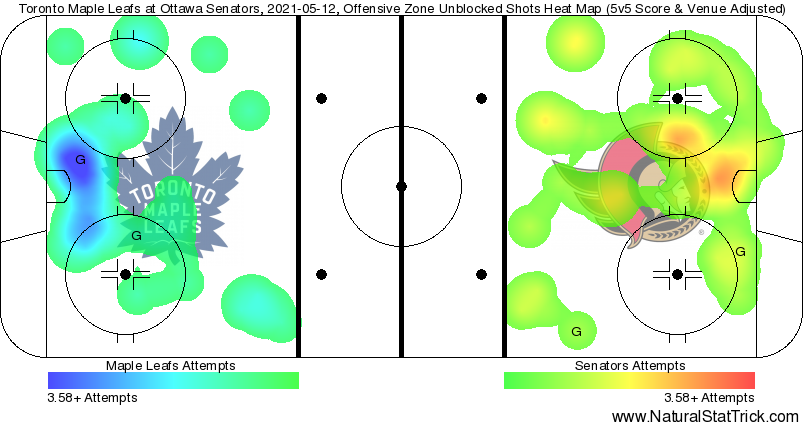 The Leafs only controlled 45 percent of the shots and 43 percent of the expected goals — against the Senators — at 5v5. It wasn’t great, but at least these games don’t actually matter.
The Leafs only controlled 45 percent of the shots and 43 percent of the expected goals — against the Senators — at 5v5. It wasn’t great, but at least these games don’t actually matter.
Game Score
Game score is a metric developed by The Athletic’s Dom Luszczyszyn to measure single-game performance. You can read more about it here.
Tweets of the Night
i recognize there are people like this, but every year it makes me laugh when people on twitter try to remind leaf fans not to get too cocky. buddy i wouldn't trust my team to beat a gang of mannequins. my rational brain says leafs in six, my paranoid heart says habs in two
— Acting the Fulemin (@ATFulemin) May 12, 2021
This is ridiculous. Paranoid heart says Habs in three.
i understand people think the leafs are cursed and will never win, but i think it’s precisely for that reason that this is the year… a year where none of their fans will get to see it actually happen live
— dom at the athletic (@domluszczyszyn) May 12, 2021
See, these are the kind of tweets that get you swept. Thanks a lot, Dom.
The rise and fall of Frederik Andersen's tenure with the Leafs, illustrated with cumulative goals saved above expected. #LeafsForever pic.twitter.com/O3ckupleGd
— JFresh (@JFreshHockey) May 13, 2021
This just makes me sad.


![Sheldon Keefe on the Maple Leafs’ struggling power play: “[We’ve scored] one out of 11 high-danger chances in tight to the net… We have been in those spots and haven’t converted” Sheldon Keefe, playoff press conference](https://mapleleafshotstove.com/wp-content/uploads/2024/04/keefe-pc-game-3-218x150.jpg)

![Jim Montgomery Post Game, Bruins 4 vs. Leafs 2: “[Marchand] still manages to get under people’s skin, yet he doesn’t cross the line” Jim Montgomery, Boston Bruins post game](https://mapleleafshotstove.com/wp-content/uploads/2024/04/jim-monty-pg-to-218x150.jpg)




















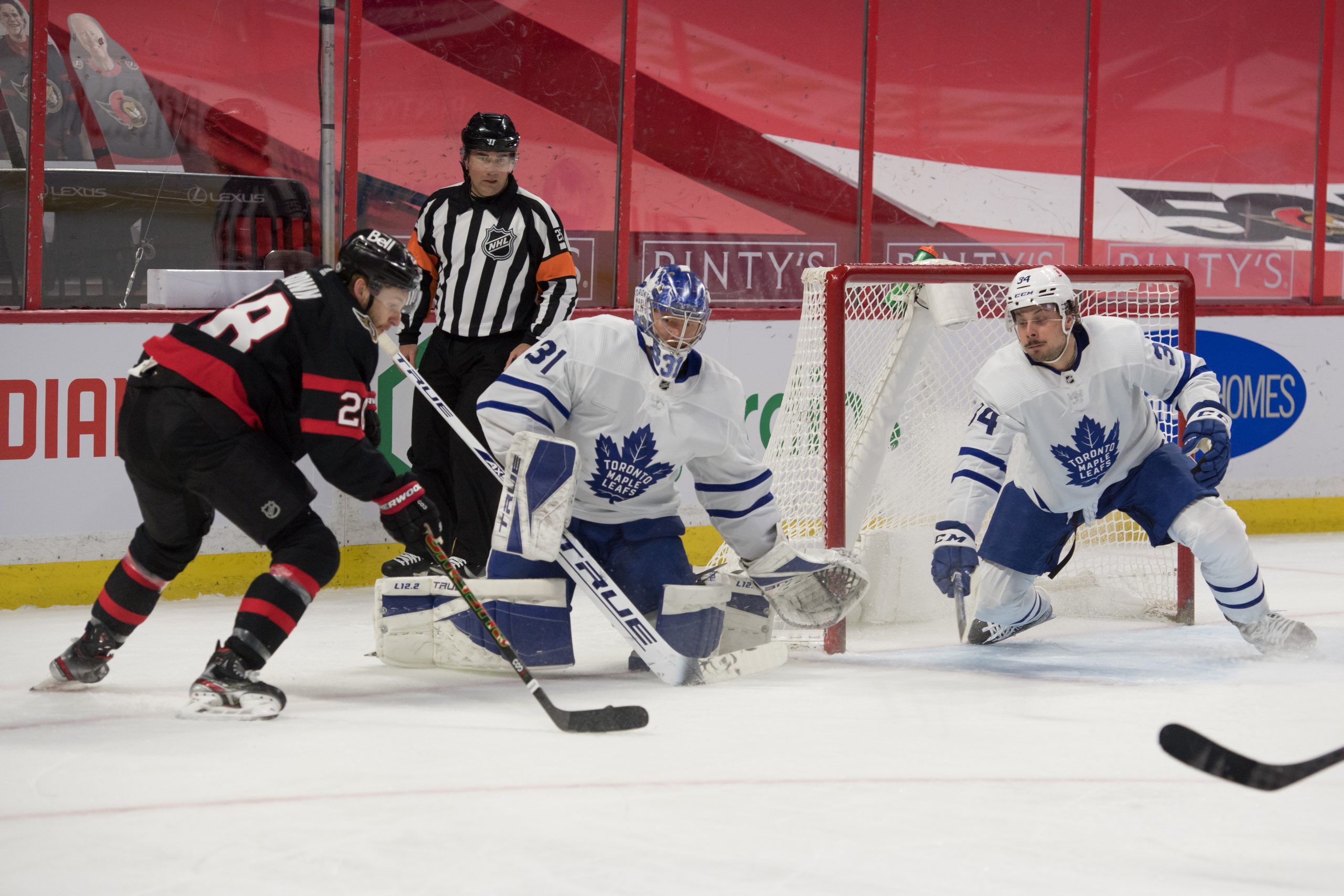
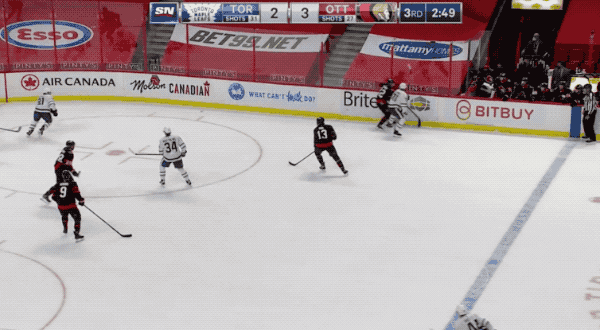
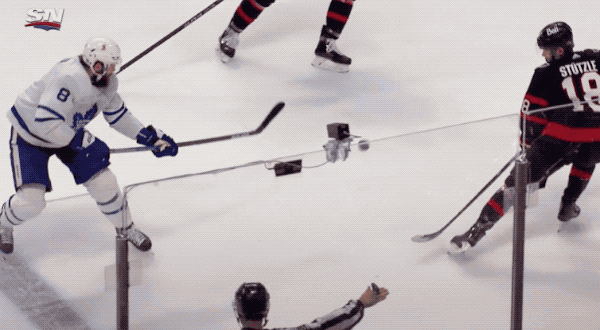
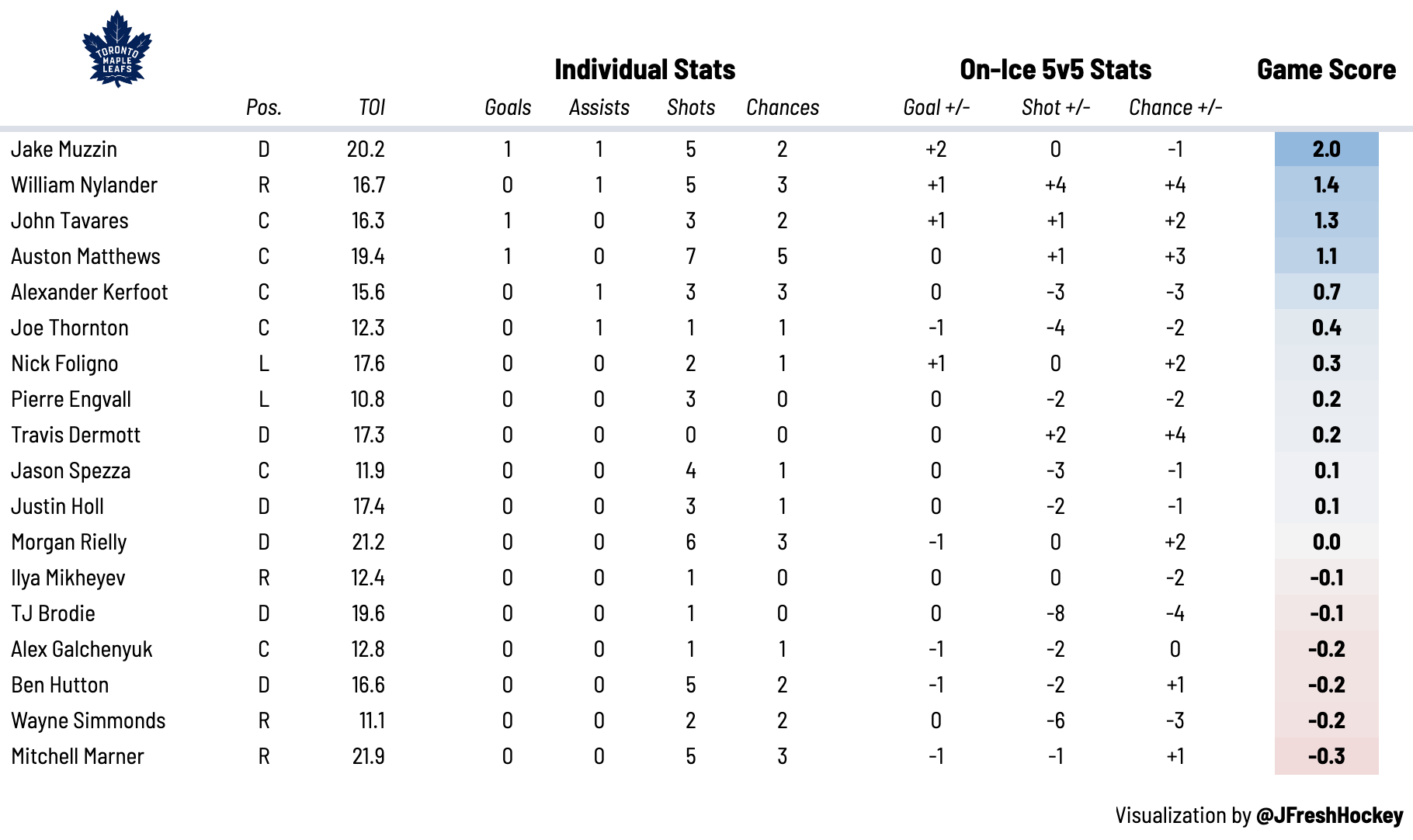





![Sheldon Keefe on the Maple Leafs’ struggling power play: “[We’ve scored] one out of 11 high-danger chances in tight to the net… We have been in those spots and haven’t converted” Sheldon Keefe, playoff press conference](https://mapleleafshotstove.com/wp-content/uploads/2024/04/keefe-pc-game-3-100x70.jpg)



![Jim Montgomery Post Game, Bruins 4 vs. Leafs 2: “[Marchand] still manages to get under people’s skin, yet he doesn’t cross the line” Jim Montgomery, Boston Bruins post game](https://mapleleafshotstove.com/wp-content/uploads/2024/04/jim-monty-pg-to-100x70.jpg)

